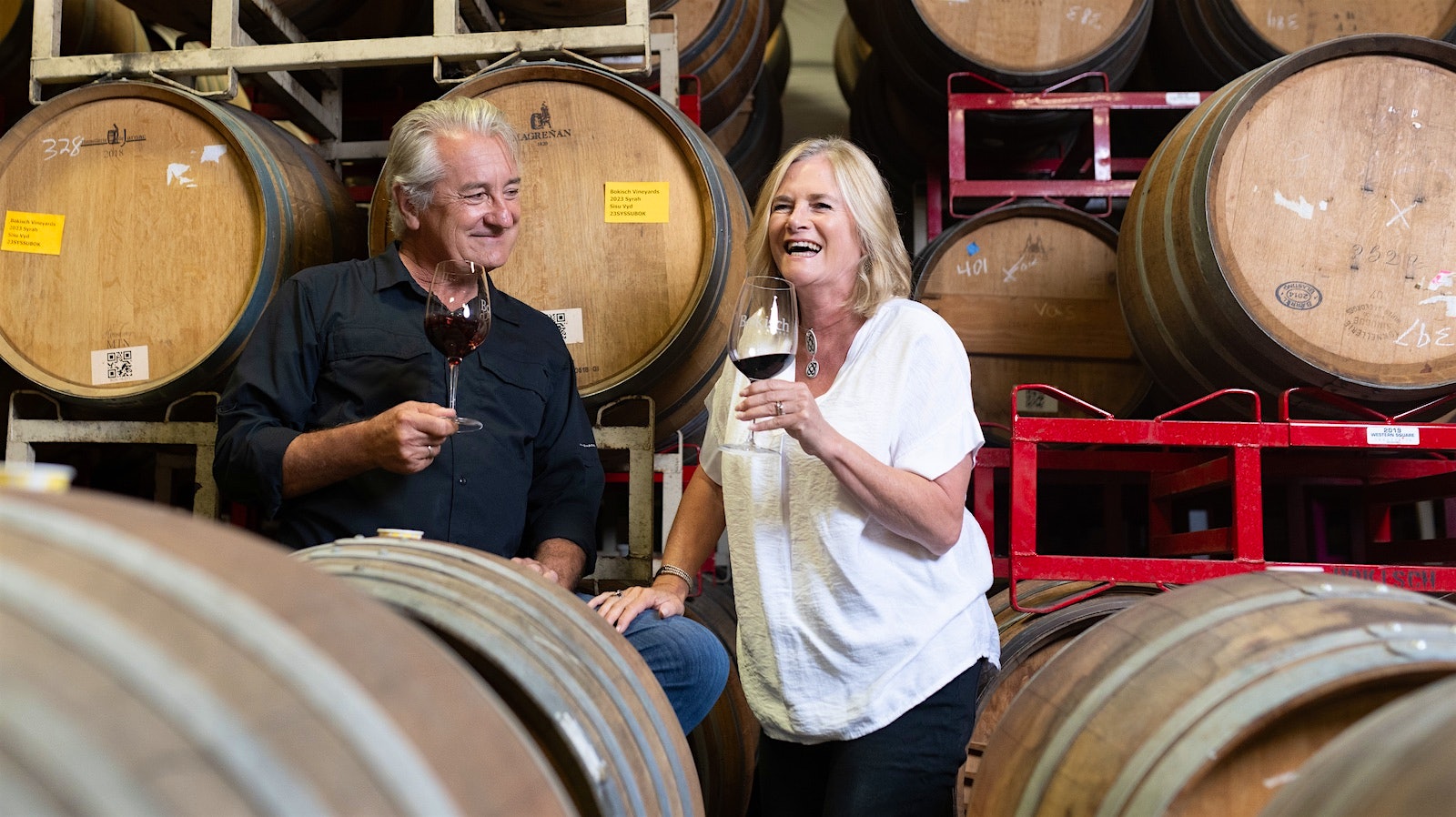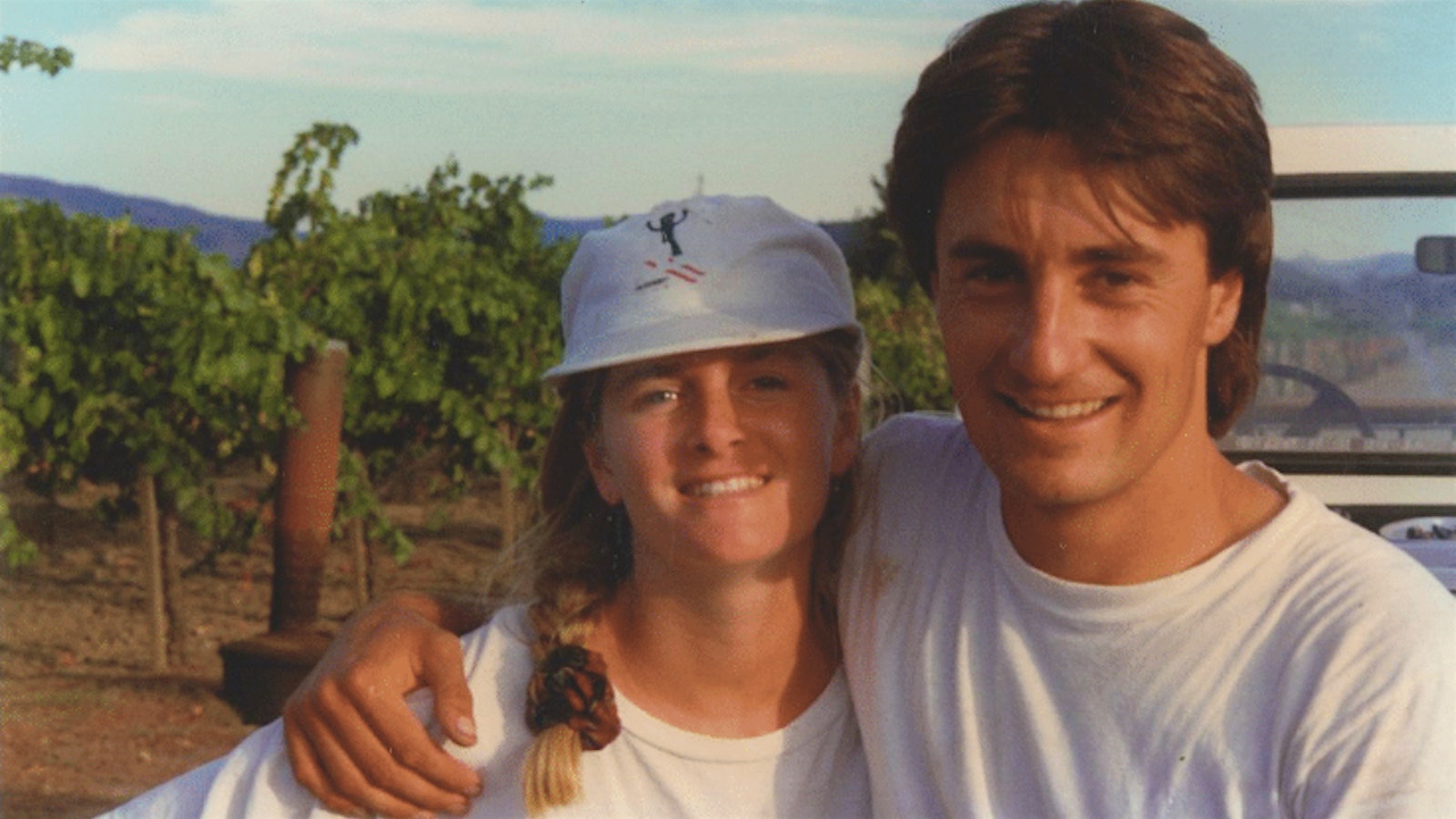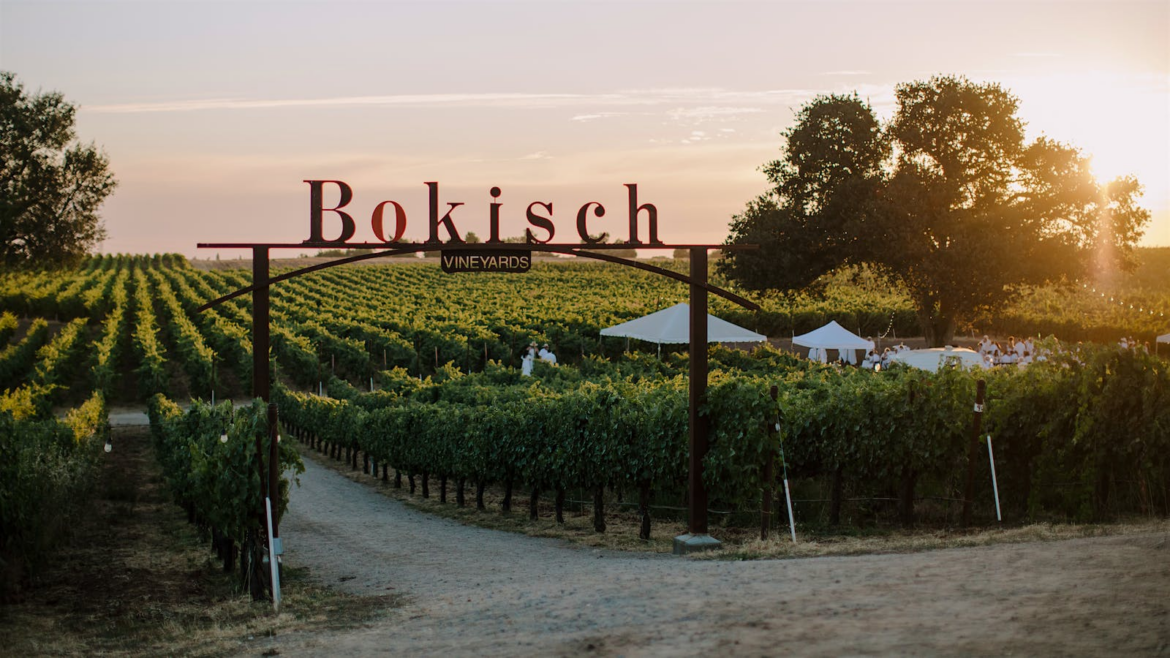The story of how Bokisch Vineyards began sounds a little like something you’d hear while watching an episode of House Hunters: Markus Bokisch, who spent his childhood summers visiting his rice-farming Catalan family in La Ràpita, Spain, meets California native Liz while they’re attending UC Davis.
The newlyweds travel to Spain in 1992, living out of a 1967 Volkswagen bus in the Cava-producing town of Sant Sadurní d’Anoia while Markus chased his winemaking dream and Liz taught English.
But in this episode, the couple brings their love of Spain back to the U.S., buying land in Lodi’s Clements Hills AVA in 1995 and becoming California pioneers for Spanish varietals.
“There were so many naysayers when we started,” recalls Markus, who counterpoints with the Wente family’s history of bringing Chardonnay to Livermore Valley. “Burgundy and Livermore Valley have nothing to do with each other, and yet they grow beautiful Chardonnay. So don’t tell me I can’t do Albariño.”
Clements Hills’ Mediterranean climate features diurnal temperature fluctuations, with cooling breezes from the Sacramento–San Joaquin Delta to the east and cold air coming down from the Sierras to the west. And it has proved ideal for Spanish grape varieties, nine of which are now farmed at Bokisch Vineyards, including Albariño, Tempranillo, Verdejo and Monastrell. (Bokisch also makes Syrah, Malbec, Chardonnay and more under its Tizona label.)

Markus and Liz Bokisch have brought Catalonian culture and wine to California’s Central Valley. (David Hammond Brown)
Markus, who’d been working as a viticulturist for Joseph Phelps in the mid-’90s, says he searched all over Lodi, Lake County and even Napa before he and Liz planted their Terra Alta Vineyard, named for the DO nearest his family in Spain.
He was looking for indicator species, specifically blue oaks. “Those are the most drought-tolerant species in California,” he says, gesturing toward a massive blue oak atop a knoll of the gently sloping Terra Alta.
“That would tell me, OK, this ground has got to be pretty shitty; this is where Spanish varieties are going to do well,” he laughs, noting that most Spanish grapes are accustomed to dry farming, and that Clements Hills’ constrained soils, comprising primarily clay loams with granitic and volcanic sediment, yield concentrated fruit flavors.
Growing Spanish Wine Grapes in California
Of course, Spanish varieties were virtually non-existent in California in the mid-1990s …
“That’s the nice thing about not being from a place. You can come in and see it as a blank slate,” says Liz of their move from Napa to Lodi to grow Spanish grapes. “But the hardship is that we didn’t have guidance. We had to kind of do it on our own.”
In the Bokischs’ case, they quite literally did everything on their own. At the time, UC Davis’ Foundation Plant Services was woefully underdeveloped when it came to Spanish grapevine planting stock. Markus voiced his frustrations to the foundation’s director, encouraging UC Davis to build relationships with Spanish universities and bring more Spanish clonal material into the U.S., but nothing ever came of it. “So that’s when I said, ‘OK, I’m going to bring in a whole bunch of cuttings myself,’” he says.
After testing the cuttings for disease, he planted his first vines in 1998. He later gifted his collection, including Albariño clone 1 from Rías Baixas and Tinto Fino clone 12 (Tempranillo) from Ribera del Duero, among others, to UC Davis.
And while he ruffled a few UC Davis feathers with his illegal imports, California wine lovers are nevertheless grateful for his efforts, as today there are hundreds of acres of Spanish varietals in the Golden State. “I could have collected royalties,” Markus says, “but I knew that if they were free for anyone who wanted them, more people would be willing to plant them. And the rising tide lifts all boats, you know?”
From Farmers to Vintners Forging Their Own Path
“When we started, there was no way to compare notes,” chuckles Markus of Bokisch’s first vintage, in 2000. He says that in those first few years they treated Albariño similarly to Chardonnay, resulting in an overtly unctuous and peachy style. “It took us four years to realize we are not Rías Baixas,” he says.
Following the then-common California method of waiting for flavor development in the grapes led to excessive ripeness, especially in Lodi’s warm climate. Today, he picks the Albariño at around 20 or 21 Brix. “I don’t care if I can’t taste flavors in the grapes,” he says, “because I know all the precursors are there.”
The aromatic, crisp and intensely flavored Bokisch Albariño now represents 20 percent of the winery’s annual production. Similarly, with the Tempranillo, Markus learned that if he let it hang too long, the grapes wouldn’t retain their acidity before harvest.
“If you wait for flavors, you end up getting wines that are kind of soapy and over 4.0 pH; so we pick it by acid,” he says, adding, “The only way to get good acid and good sugar is low yields. So we are like hawks on yield, and get 25 brix at 3.6, 3.7 pH.”
As they evolved their approach, finishing construction on the winery at Terra Alta Vineyard in time for the 2014 vintage was a significant turning point for Bokisch Vineyards, says Liz. 2014 also marked the inaugural vintage of the winery’s Gran Reserva Tempranillo. Following the rules for a traditional Rioja gran reserva, which include a minimum of five years of aging, Bokisch’s deeply fruity, spicy and balanced Gran Reserva Tempranillo is made only in quality vintages and ages for 36 months in barrel, followed by two years in bottle prior to release.
Given the current trend toward lighter-style wines, Liz sees opportunity in styles inspired by Spain’s classification system. “We haven’t really tried a crianza, but it’s something we’ll probably add to the lineup.”
One of the newest additions to the Bokisch lineup also represents the zenith of their winemaking journey: a sparkling wine called Lo Xalet. “Xalet” is a Catalan word for a seaside home, and Lo Xalet is a tribute to Markus’ grandparents and their home where his love for Spain began.
Markus established the nearby 23-acre Miravet Vineyard in 2016 with entirely Spanish varieties, including the three traditional Cava grapes: Xarel-lo, Macabeo and Parellada.
“We started with two intentions in mind,” says Markus. “First, we wanted to make a quintessentially Spanish sparkler. Second, to play with the varieties as [standalone] still wines. I believe all three, and particularly the Xarel-lo, are ideally suited to our Northern California climate.”
For the Lo Xalet bottling, each of the three grape varieties is picked and vinified separately, then blended and made in the traditional method, including nine months en tirage (aging on the lees), for a bone-dry, lively bubbly with mineral tinges to the crunchy pear and citrus flavors. They just can’t call it Cava (Cava is a legally protected term under the European Union’s Protected Designation of Origin rules). “We can’t even say Cava-style,” says Liz. “But we can say it is inspired by the time we lived in Penedès.”
Penedès ignited a dream in Markus and Liz, who are celebrating their 25th harvest this year. Their willingness to push boundaries, take risks and pioneer less common Spanish varietals has helped Lodi shift from its history of producing large-volume wines from mainstream varietals towards more premium wines, while simultaneously solidifying their position as pioneers.

Liz and Markus Bokisch followed their hearts to Spain in the mid-1990s. (Courtesy of Bokisch family)
Reflecting on their 25 years, Markus says pioneering Spanish varieties in Lodi hasn’t been without its challenges. But as the broader industry faces a glut in production, he sees a silver lining: grapes like Albariño and Tempranillo have provided a buffer.
“We’re not really experiencing that [glut], because we’re doing something few people do,” he says.
“A happy accident,” interjects Liz. “We’ve focused entirely on that vigneron concept of growing our own grapes, producing and selling our wine right here on the property. And then the focus of your Spanish culture, and the food and wine, all come together. It’s taken us 25 years to get where we’re at, but we’ve done it ourselves.”
The couple now farms 104 acres of both Spanish and non-Spanish varietals organically, keeping about one-fifth of the production from three estate vineyards for Bokisch while selling the rest to other wineries.
What began as an ambitious adventure in California’s Central Valley has blossomed into a genuine reflection of Markus and Liz’s love for Spain. From vineyard names to winemaking traditions to the wine labels, many of which feature brightly hued Spanish tile designs, there’s a tremendous sense of warmth and authenticity as Markus and Liz share their story. “It all really speaks to our hearts,” says Liz.
And their hearts are as big as their smiles as they raise a glass of Lo Xalet to their stand-in Catalonian home in Lodi.
Visit Bokisch Vineyards Winery and Tasting Room
Bokisch Vineyards
18921 Atkins Road, Lodi, CA
Tastings daily
Telephone: (209) 642-8880
Website: bokischvineyards.com
Read all of our Winery Intels, follow senior editor Aaron Romano on Instagram at @aaron_romano_wine, and never miss an update with Wine Spectator’s free email newsletters.


Dining and Cooking